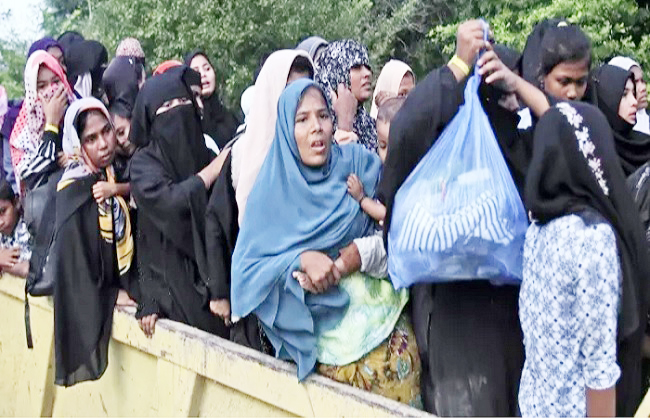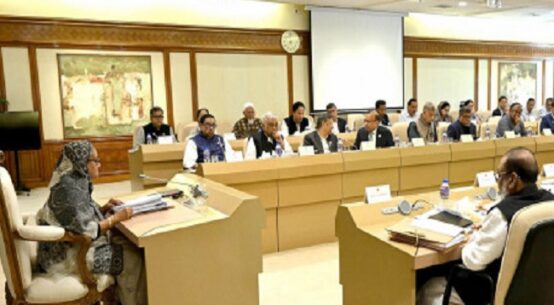
The Human Rights Watch has said about one million Rohingya refugees are facing increasingly dire conditions in the Cox’s Bazar camps amid surging violence by armed groups and criminal gangs.
In August alone, it said, there have been reports of members of the Rohingya Solidarity Organisation and Arakan Rohingya Salvation Army carrying out killings, abductions, forced recruitment, extortion, and robbery, said a Human Rights Watch statement issued on Friday.
Bangladesh authorities have failed to ensure refugees access to protection, education, livelihoods, and movement, said the global Rights body.
“My heart aches for the safety of our Rohingya students and the entire community in the area,” a Rohingya teacher in the camps wrote in a note to Human Rights Watch.
His students have been increasingly absent from classes, he said, either abducted for ransom, unlawfully recruited, or kept home by their parents out of fear. “Brutal gang activity has created a climate of terror. The fear is palpable, a suffocating weight.”
Bangladesh’s interim government chief adviser, Prof Muhammad Yunus, said he will “continue to support the million-plus Rohingya people sheltered in Bangladesh.”
Foreign Adviser Md Touhid Hossain said they are not in a position to accept any more refugees.
Rohingya refugees in Bangladesh have consistently said they want to go home but only when their safety, access to land and livelihoods, freedom of movement, and citizenship rights can be ensured.
Since January 2023, more than 5,000 Rohingya have attempted dangerous boat journeys to Indonesia and Malaysia in the hope of a better life. An estimated 520 of them have died or gone missing.
While the international response to the 2017 violence was meager and no one has yet been held to account for the crimes against the Rohingya, there have been some important steps toward justice, Human Rights Watch said.
In June, an Argentine prosecutor requested arrest warrants for 25 individuals within the Myanmar political and military authorities.
The case was filed under the principle of universal jurisdiction, which allows national authorities to prosecute suspects of grave crimes regardless of nationality or where the crimes were committed.
In July, the International Court of Justice (ICJ) accepted the interventions of seven governments in Gambia’s case against Myanmar under the Genocide Convention. Hearings on the merits of the case will most likely take place in 2025.
At the same time, the International Criminal Court (ICC) has an ongoing investigation into the situation, although its jurisdiction is limited to alleged crimes committed at least in part in Bangladesh, an ICC member country.
The UN Security Council should expand the ICC’s jurisdiction in the case by referring the situation in Myanmar to the court, Human Rights Watch said.
Council members have so far not followed up on the December 2022 resolution with tangible measures, fearing vetoes by China and Russia.
Security Council members should support holding an open meeting to address the deteriorating situation in Rakhine State and build momentum for a follow-up resolution under Chapter VII of the UN Charter.
The council should also play a role in enforcing the binding provisional measures ordered by the ICJ in the genocide case, which the military has blatantly disregarded.
Rohingya Muslims in Myanmar are facing the gravest threats since 2017, when the Myanmar military carried out a sweeping campaign of massacres, rape, and arson in northern Rakhine State, Human Rights Watch said today.
August 25, 2024, marks the seventh anniversary since the start of the military’s crimes against humanity and acts of genocide that forced more than 750,000 Rohingya to flee to Bangladesh.
In recent months, the Myanmar military and the ethnic Arakan Army have committed mass killings, arson, and unlawful recruitment against Rohingya communities in Rakhine State.
On August 5, nearly 200 people were reportedly killedfollowing drone strikes and shelling on civilians fleeing fighting in Maungdaw town near the Bangladesh border, according to Rohingya witnesses.
About 630,000 Rohingya remain in Myanmar under a system of apartheid that leaves them exceptionally vulnerable to renewed fighting.
“Rohingya in Rakhine State are enduring abuses tragically reminiscent of the military’s atrocities in 2017,” said Elaine Pearson, Asia director at Human Rights Watch. “Once again, armed forces are driving thousands of Rohingya from their homes with killings and arson, leaving them nowhere safe to turn.”
“Over the past seven years, UN bodies and governments haven’t done enough to end the system of apartheid and persecution that has exposed Rohingya to further suffering,” Pearson said.
“Ending the ongoing cycles of abuses, destruction, and displacement requires international efforts to hold those responsible to account.”
Rohingya are being pressured from all sides in Myanmar and Bangladesh, Human Rights Watch said.
In recent months, the junta has unlawfully recruited thousands of Rohingya men and boys from Rakhine State and the refugee camps in Bangladesh, with support from Rohingya armed groups, inflaming tensions between the Rohingya Muslim and Rakhine Buddhist communities.
Rohingya have been caught in the middle of the fighting since hostilities resumed in November 2023, ending a year-long unofficial ceasefire.
As the Arakan Army has rapidly expanded its control across Rakhine State, the military has responded with indiscriminate attacks on civilians using helicopter gunships, artillery, and ground assaults.
In late April, Arakan Army forces began attacking Rohingya villages in Buthidaung, culminating in their May 17 capture of the town, during which they shelled, looted, and burned Rohingya neighborhoods.
Armed clashes have since moved west to Maungdaw, spurring further abuses and displacement, including arson and looting. Four videos from the August 5 attacks shared on X, formerly Twitter, on August 6 show dozens of bodies of men, women, and children.
Geoconfirmed identified the location, which Human Rights Watch corroborated, at the western edge of Maungdaw town. Rohingya witnesses told Human Rights Watch they believed the Arakan Army was responsible.
The junta and Arakan Army have blamed each other for the attacks.
“Over the last two months, there was serious fighting between the Arakan Army and Myanmar military, with artillery shells and drones,” said a 24-year-old Rohingya man from Myo Ma Ka Nyin Tan, Maungdaw, in August.
“Many Rohingya villagers were killed and injured every day. I went to several funerals.” He fled on August 5 when fighting descended on his neighborhood. “We made our way to the riverbank to cross, where thousands of people were making the journey.
Suddenly, drones appeared and started dropping bombs on the crowd. In our group of 70 to 80, close to 20 were killed, and 10 others, including myself, were injured.”
“The Naf River was full of dead Rohingya bodies as we fled,” said another villager, 18, who told Human Rights Watch that his father was killed in a drone attack. “I saw many dead bodies in the paddy fields and on the riverbank.”
His boat capsized in the river while crossing into Bangladesh, drowning two dozen people.
He and his brother found a plastic barrel which they floated on to the shore.
The Border Guard Bangladesh arrested his mother while she attempted to cross the border and have detained her since, he said.
Border guards have increased pushbacks of asylum seekers along the Rakhine border since January.
The conflict has displaced more than 320,000 people in Rakhine State and southern Chin State since November 2023.
Meanwhile, the junta has ramped up its deadly blockages of humanitarian aid as a form of collective punishment, which is in violation of international humanitarian law and contrary to the 2022 United Nations Security Council resolution and Association of Southeast Asian Nations (ASEAN) five-point consensus.


